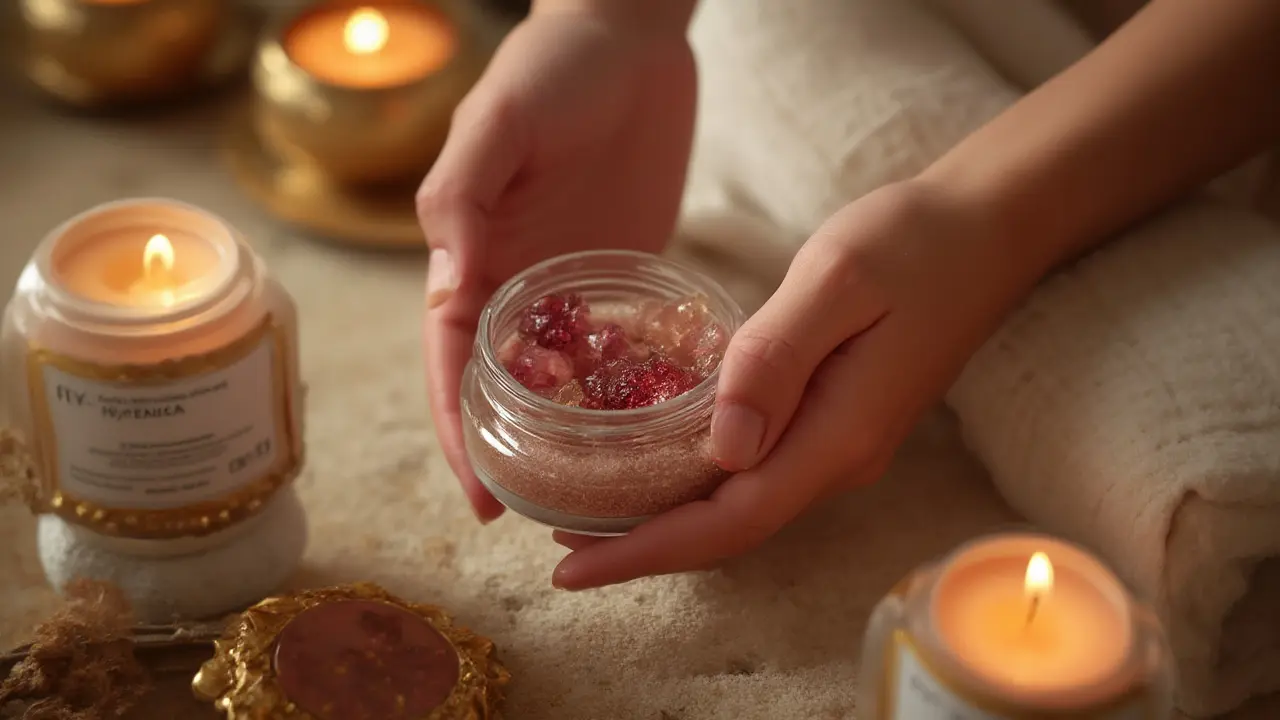Ever tried a new body scrub only to wonder if you’re even using it right? There are so many spa tips online, but there’s a heated debate in every beauty forum—should you slather your scrub on while you’re still dry or after you hop in the shower? You’d think there’s some secret code to unlocking that soft-skin magic, and, honestly, there kind of is. In Dubai’s top spas, guests often get this question—and there’s more science to it than you might expect. A lot of people see scrubs as just another product, but the way you use them changes everything about the results. The real difference comes down to how your skin is prepped and what you want to get from your exfoliation session. And it’s not always one-size-fits-all.
How Does Body Scrub Exfoliation Work?
Exfoliating with a body scrub is more than just scrubbing off dead skin. It’s about boosting skin turnover, getting rid of dullness, and making way for smoother, more radiant skin underneath. Here in the desert, between the heat and air conditioning, skin gets flakier, faster. That’s why exfoliation is a weekly ritual for so many people in Dubai. Body scrubs typically contain granules, like salt, sugar, or even crushed seeds, suspended in a creamy or oily base. These little granules do the heavy lifting, physically buffing away dead skin cells while the base adds hydration or delivers soothing ingredients. You might see spa therapists using circular motions—this helps boost circulation and makes the process even more effective. Plus, regular exfoliation means lotions and oils absorb better, so your post-shower routine becomes even more effective.
How aggressive you want that exfoliation to be depends on your skin type and how hydrated your skin is at the time. Dry scrubbing is more intense and really good for rough patches (think elbows or knees), while wet scrubbing is gentler and suited for sensitive or easily irritated skin. Both methods have die-hard fans, and both have their place if you know what you’re doing. The trick isn’t just what you use, but how and when you use it. You don’t need to turn your bathroom into a spa to get results—just understanding why exfoliation works goes a long way. Dermatologists say that keeping up with regular exfoliation can actually slow visible signs of aging—something most people don’t realize until they see smoother, brighter skin for themselves. With the right routine, you can even help lessen the look of strawberry legs or keratosis pilaris over time.
Let’s look at what happens to your skin during exfoliation. When you use a body scrub, the grit dislodges loosened skin debris and buildup, but it also gently “wakes up” your circulation. That post-scrub tingle isn’t just in your head; increased blood flow brings oxygen and nutrients to the surface, giving you that instant glow. Oil-based scrubs do double duty, sloughing and moisturizing in one step. In spa settings, we often finish with a cool rinse to close up pores, sealing in moisture. Dry brushing and scrubbing have even grown popular for a pre-tan or pre-wax prep. It’s not just about looking good—it’s about getting the most out of every product you use afterward.
Should You Apply Body Scrub to Wet or Dry Skin?
This is THE question clients ask the most. The truth is, both wet and dry scrubbing have unique benefits—and the answer really depends on what you want from your session and your skin’s condition. The key difference is intensity. Applying scrub on dry skin gives you a stronger exfoliation, ideal for thick, rough spots or before a spray tan. If you’re craving that deep clean feeling and your skin isn’t too sensitive, dry scrubbing can do wonders. The granules don’t dissolve as fast on dry skin, delivering more “grit per rub,” so you get a thorough polish. On the flip side, if you lather scrub on wet skin, especially after a warm shower, it’s much gentler. Warm water softens the skin and opens up pores, letting ingredients penetrate more deeply without as much risk of overdoing it. This is perfect for everyday use or if you have any kind of irritation.
Let’s get specific. A 2023 spa industry survey in the UAE found that 67% of spa clients prefer applying scrubs on wet skin, mainly because it feels more soothing, but 23% go with dry application, especially before professional treatments. The rest switch it up, using both methods depending on season and how their skin feels week-to-week. If you’re battling body acne or keratosis pilaris, wet scrubbing is usually better because it reduces risk of micro-tears from aggressive friction. For a quick glow before a night out, dry scrubbing can give instant results—but always be gentle and don’t overdo it.
Still torn? Just look at your scrub’s packaging. Most OTC (over-the-counter) scrubs say to use on damp skin, but some pro or natural brands encourage dry use for max exfoliation. Salt scrubs, being more abrasive, often work best wet. Sugar scrubs, with their fine-rounded edges, can be used drier. Traditional Middle Eastern and Asian hammam rituals usually do a blend—starting with steam, then dry scrubbing, followed by a rinse and oil application. This multi-phase approach gets the best of all worlds. What about those viral “pre-shower” dry scrubs? They’re most popular for prepping before a tan but should always end with a rinse and moisturizing to avoid drying out your skin. If you’re unsure, test on a small spot first and tweak your method over time to match your skin’s mood.

Expert Spa Tips for Maximum Results & Common Mistakes
Timing and prep are everything. For the best experience, start with a warm shower or bath to soften dead skin, making exfoliation both safer and more effective. Skip bar soaps beforehand, as they can create a film that blocks the scrub’s action. After rinsing off sweat and daily dirt, pat excess water but keep your skin damp—this is the sweet spot for most scrub formulas. Apply in circular, upward motions to boost lymphatic drainage and circulation; work from your feet up toward your heart. This isn’t just spa mythology—lymph flow genuinely responds to this direction, helping your body shed toxins faster. If you have super dry or rough skin patches, try dry scrubbing right before you hit the shower, focusing on knees, elbows, and heels. But always avoid broken, sunburned, or freshly shaved skin, or you’ll risk stinging and microtears.
Never press too hard. The biggest mistake people make is thinking harder scrubbing means better results. In reality, using too much pressure can inflame and upset the skin barrier, leading to redness or peeling. The granules should do their job—your hand is just the guide. For faces, ditch the body scrub altogether or pick a milder version to avoid harsh abrasion. After scrubbing, always rinse with cool-to-lukewarm water, not hot, then pat skin dry and layer on a good, fragrance-free moisturizer to lock in all that smoothness you just worked so hard for. Don’t skip this step—without it, you might feel tight or itchy, especially in dry climates like the UAE.
Frequency matters, but it isn’t the same for everyone. Most experts suggest full-body exfoliation 1–3 times a week, depending on skin type. Sensitive or mature skin? Once should suffice. Oilier or constantly outdoors? Twice weekly is usually fine. If skin feels raw or irritated afterward, cut back. Don’t use any acids or retinol right after exfoliation unless you know your skin can handle it—they can compound irritation. And remember, men’s skin tends to be thicker, so a grittier scrub or dry application might work better, but always listen to your skin. Pairing exfoliation with a spa massage amplifies results, since muscles are loosened and skincare absorbs more deeply. And if you’re prepping for a special event (think beach day or a traditional hammam), start exfoliating a few days in advance—never the night before—to allow your skin time to calm and glow.
| Scrub Type | Recommended Use | Intensity | Best For |
|---|---|---|---|
| Sugar Scrub | Wet or dry; gentle, dissolves easily | Mild | Dry to normal, sensitive skin |
| Salt Scrub | Wet; abrasive, sharp granules | Strong | Rough, dull patches |
| Coffee Scrub | Wet or dry; can stain, invigorating | Medium | Cellulite-prone, inflamed skin |
| Seed/Nut Scrub | Wet; usually in oil base | Varies | All types, most hydrating |
One last expert trick—alternating scrub types keeps things fresh. If you stick to just one style all year, your skin can get used to it and results might plateau. Swapping sugar for salt or adding a clay-based scrub every month can reset results. And always keep hygiene in mind, especially with DIY or “open-pot” scrubs. Scoop them out with a clean spoon, not your fingers—no one wants to introduce bacteria back onto freshly buffed skin.
Frequently Asked Questions
- Do you put body scrub on wet or dry skin? Most scrubs work best on wet skin for gentle exfoliation, but dry application gives more intense results for rough areas.
- How often should I use a body scrub? For most skin types, 1–3 times per week is safe. Go less often if your skin is sensitive or easily irritated.
- Can I use body scrub on my face? No, body scrubs are too abrasive for the face. Use a scrub specifically labeled for facial use instead.
- Should you moisturize after exfoliating with a body scrub? Absolutely. Moisturizing after exfoliation helps lock in hydration and soothes the skin barrier.
- Is it okay to use a body scrub if I have body acne? Yes, but opt for fine, gentle scrubs on wet skin and avoid harsh formulas or heavy pressure.



